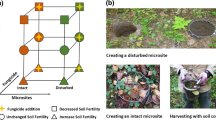Abstract
This study quantified intersite variation and spatial pattern in arbuscular mycorrhizal (AM) and ectomycorrhizal (ECM) infectivity of soils among six sites constituting a successional chronosequence in southwestern Ohio, USA. The study sites included an active agricultural field (chronic disturbance), a site which had been stripped of its surface soil (pseudo-stripmine, acute disturbance), 5- and 10-year-old fields, a 25- to 30-year-old prairie restoration, and an undisturbed, mature forest. AM infectivity was lower in the agricultural field, successional fields, and prairie than in the mature forest, but there was no clear correlation between time since disturbance and the overall level of AM infectivity. Spatial structure in AM infectivity decreased with time since disturbance. In the pseudo-stripmine site and active soybean field, semivariance analysis attributed 44–50% of the total variance in AM infectivity among samples to spatial structure, whereas spatial dependancy accounted for only 18% of total variance in the mature forest. Kriging of AM infectiveness demonstrated small, isolated areas in the disturbed plots that were devoid of AM infectiveness, whereas the kriged AM maps of the other four sites showed AM infectiveness to become progressively more homogeneous. ECM infectiveness was lacking from 35–50% of the samples from the disturbed sites, and both overall ECM infectiveness and ECM diversity increased with time since disturbance. Approximately 44% of the variance in ECM infectiveness was related to spatial structure in the two disturbed sites, and large areas entirely devoid of ECM infectivity were present on the kriged ECM maps for these sites. There was less spatial structure in ECM in the old fields and prairie and very little in the mature forest. The results of this study emphasize the need to explicitly evaluate spatial heterogeneity in mycorrhizal infectivity in studies of the role of mycorrhizae in succession.
Similar content being viewed by others
Author information
Authors and Affiliations
Additional information
Accepted: 4 August 1995
Rights and permissions
About this article
Cite this article
Boerner, R., DeMars, B. & Leicht, P. Spatial patterns of mycorrhizal infectiveness of soils long a successional chronosequence. Mycorrhiza 6, 79–90 (1996). https://doi.org/10.1007/s005720050111
Issue Date:
DOI: https://doi.org/10.1007/s005720050111




